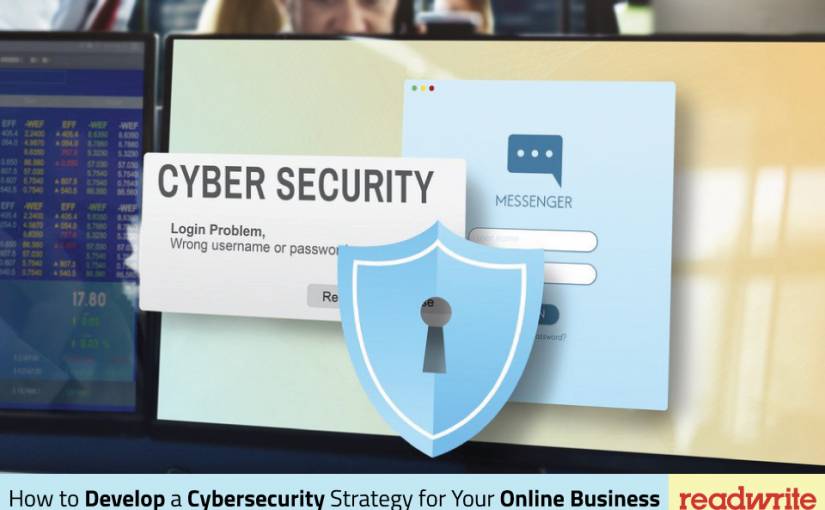Since the onset of the COVID-19 pandemic, and with the subsequent shift to work and life online, cybercrime has been booming, forming a serious threat to the digital security of businesses.
According to a recent cybersecurity report, cyberattacks are the fastest-growing crime segment in the United States. For 2022, experts predict $6 trillion in global losses – almost 60 times higher than in 2015.
How to Develop a Cybersecurity Strategy for Your Online Business
Consequently, cybersecurity has become more important than ever across the board – whether in education or investment banking. The same is true for your online business.
However, to sustainably and effectively implement cybersecurity measures, you need a strategy – no matter whether you are a solo freelancer or run a virtual team.
To help you, here is an actionable step-by-step guide for developing a cybersecurity strategy for your online business.
1 – Understand the Risks and Raise Awareness in your Team
To begin with, you need to educate yourself on cybersecurity challenges in your industry.
Freelancers or small core teams run many online businesses, and digital safety is often an afterthought. After all – only cyberattacks on large corporations end up in the news. Small businesses, it seems, are not attractive targets.
This is simply untrue. Out of 2020’s successful data breaches, 28% – almost a third! – affected small businesses, according to Verizon.
Similarly, CNBC reports that 43% of cyberattacks target small businesses. Moreover, the consequences of a breach can be devastating. On average, they cost businesses $200,000. Unsurprisingly, 60% of small businesses that suffered breaches find themselves unable to cope and go out of business within 6 months.
From the attacker’s point of view, targeting these businesses makes sense. While less lucrative than larger victims, they’re often low-hanging fruit. Breaching a small online business or a single freelancer and siphoning off all their clients – data is often trivial.
In creating your cybersecurity strategy, you need to be aware of these facts. More importantly, you also need to raise awareness of cybersecurity issues in your team. This includes other freelancers you might work with.
The world’s best cybersecurity strategy will fail to protect your business if your team won’t follow it – or if a less careful partner of yours is breached.
In fact, the World Economic Forum calls the lack of cybersecurity expertise and awareness in teams one of the top digital safety challenges for businesses in 2021.
For all these reasons, the first step in developing your cybersecurity strategy is researching current digital threats, both in general and especially those prevalent in your industry. Once you have a grounded idea of what you are facing, you can start work to secure your business.
2 – Take Stock of Your Current Setup, Data, and Digital Security
To develop your strategy, you need to assess your current virtual business setup. This includes 4 major components: people, hardware, software, and data.
First, you need to verify who has access to what accounts, tools, and platforms. Even for freelancers, this might not be as simple a question to answer as you may believe. Consider, for instance, the web designer who built your site, collaborating creatives on any of your cloud drives, or apps you’ve given permission.
Even something as simple as your family members using your devices can be a security risk in the long run. At this stage, also verify whether the people who can access your assets have themselves shared the credentials with anyone else.
Second, create an IT inventory. Besides computers, tablets and phones, this includes routers and external storage devices. Perform a network scan of your home and office network to see if you actually recognize all the devices that are connected. Also, check and list the technical specs and operating system (OS) versions of each device. The older the device and OS, the more vulnerable they generally are.
Third, compile a list of all the software solutions you use for your business, whether they are local apps, SaaS cloud solutions or plugins. Get an overview of the account, billing information, and access the information you use for each. For locally installed software, also note the version you are currently running.
Finally, you will need an inventory of all the data your business handles – and where that data is stored. Note which local drives, external drives, and online storage solutions you have. When doing this, be sure to highlight which data is particularly sensitive and needs to be prioritized in terms of digital security. For example, client payment information and account credentials are in this category.
3 – Protect Your Virtual Assets
As a next step, address the weak points in your current setup to protect your virtual assets.
To start with, evaluate and strengthen the passwords identified in the previous step and define who gets access to what.
This might seem menial, but weak passwords and account sharing have brought even large enterprises low.
Also, change all default credentials on your accounts and devices. Especially when it comes to your routers, there are several precautions you can take to increase security, from changing the network name and admin credentials to disabling WPS and Remote Access.
If you don’t have one yet, get a reputable password manager. This is invaluable in keeping track of all your passwords – and generating secure ones when you open a new account.
Secure your password resets, too: Set up customer service pins if you can, and don’t use real information for security questions. Where possible, enable two-factor authentication (2FA) or multi-factor authentication (MFA).
Next, go through all your devices, update the operating systems, and enable encryption and theft protection features. Updating your devices regularly is an essential element of maintaining your digital safety. The majority of technical data breaches don’t exploit new vulnerabilities, but developers have already fixed known ones. To benefit from these fixes, though, users need to actually install updates and patches.
In terms of network security, get a high-quality VPN if you ever use anybody else’s or even public Wi-Fi. A more reliable (but also more expensive) alternative would be to get a mobile router.
Finally, also to think about digital security training – both for yourself and your team members. At the very least, make a cybersecurity briefing part of the onboarding procedure for new team members and freelancers.
4 – Detect Threats, Invest in Digital Security Solutions
Once you have put measures in place to protect your assets as well as possible, move on to installing safeguards that detect incoming threats.
Most obviously, you need to have antivirus software installed. Given the potential cost of a cyber breach, consider investing in a paid plan by a reputable, well-established antivirus provider (see: techradar dotcom — best antivirus). Examples include Bitdefender, Norton, or Kaspersky. Make sure to stick to a fixed schedule for installing updates on your antivirus and perform scans regularly.
When comparing solutions, comprehensive options have advantages over combining stand-alone services by different providers. Many vendors offer bundles that are simple to set up, yet combine VPNs, encryption solutions, backups, and various kinds of real-time protection.
Going even further, some services such as Aura provide all-encompassing digital security solutions that go beyond your system. They combine technical aspects like Wi-Fi protection, VPN, and antivirus with credit monitoring, reputation monitoring, and identity theft insurance.
5 – Set up a Response Plan to Round off Your Cybersecurity Strategy
The final part of your strategy to protect yourself from breaches is setting up a plan for how to respond to them.
Clearly define a procedure for worst-case scenarios, such as identity theft, a successful phish, or a ransomware attack. Layout all the steps you would have to take in each case – from wiping affected devices to requesting credit freezes.
Also, keep a list of those who need to be notified if your business is compromised, and who could help you if a breach does happen.
Having this information at your fingertips is invaluable if worse comes to worst. Responding swiftly to a suspected breach is critical to minimize the damage to your business and reputation.
The Bottom Line
Setting up a cybersecurity strategy to protect your online business is essential to operating in the virtual sphere in 2021. The cost of a data breach in your business is potentially devastating both in terms of reputation and finances.
By following the steps outlined in this article, you’ll be able to develop an actionable strategy to minimize the risk of breaches. And to swiftly respond in case they do happen. Ultimately, this will help you operate more safely. And you’ll be able to rest assured that both your own and your client’s data is as secure as it can be.











